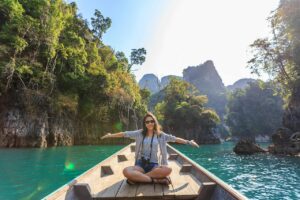While some prefer a vacation relaxing on the beach, others look for an adventure with a dangerous thrill to it. From boiling-hot lakes to high peaks and deadly dives, these locations will get your heart racing.
Darvaza gas crater, Turkmenistan

This flaming pit, also known as the “Gates of Hell”,” was created in the 1970s when geologists drilled for oil in a cave and caused the natural gas field there to collapse. To burn off the toxic gas, they set it on fire. Decades later, it’s still burning in the remote Karakum Desert.
Death Valley, USA

Death Valley in California lures visitors in with its surreal landscape of sand dunes, rock-salt spires, and salt flats. However, with a record temperature of 130°F (54.4°C), its extreme heat can be fatal.
Villarrica, Chile

A popular location for adventure hikers, Villarrica is one of South America’s most active volcanoes. It last erupted in 2015, spewing ash and lava up to 3,300 feet (1,000 m) in the air.
Mount Huashan, China

Located in China’s Shaanxi province, Mount Huashan has long been a place of pilgrimage thanks to its sacred five peaks and Taoist temples. It’s also famous for its network of steep and dangerous trails that snake around the mountain.
Karijini National Park, Australia

Filled with red gorges and emerald pools, this wild and beautiful national park is an Australian pearl. However, located in the remote part of Western Australia, it’s prone to extreme weather conditions and rockfalls, which have led to fatalities.
Skellig Michael, Ireland

A dangerous place to access, the craggy isle off the coast of County Kerry was once home to monks. It has since been used as a filming location for ‘Star Wars VII: The Force Awakens’ (2015).
El Caminito Del Rey, Spain

Built between 1901 and 1905 for construction workers carrying goods, the risky path attracts adrenaline junkies from around the world. With several hikers having fallen to their deaths there over the years, the path today has new visitor restrictions, making it much safer than it once was.
Mount Everest, Nepal

Climbing the world’s tallest mountain is on the bucket list of many. At over 29,000 feet (8,850 m), Mount Everest attracts around 1,200 climbers each year. However, only about half ever reach the summit, and several others die trying. The main causes of death on Everest include subfreezing temperatures and changing altitudes. In 2019, 11 people died on the peak.
Devil’s Pool, Victoria Falls, Zambia and Zimbabwe

During the drier months of the year, the Zambezi River gets low enough to reveal the ultimate infinity pool at the edge of the world’s highest waterfall, Victoria Falls. Swimmers take the plunge at their own risk, as they could be swept down the waterfall.
Half Dome, USA

Located above Yosemite National Park in California, the 14-mile (22.5-km) round trip to the top takes hikers into the wilderness. It also has a reputation for dangerous and deadly conditions. After falling 500 feet (150 m) in 2019, one hiker was tragically killed.
Cliffs of Moher, Ireland

One of Ireland’s most impressive sights, the Cliffs of Moher feature a dramatic scenery that unfolds for five miles (eight km), reaching more than 700 feet (over 210 m) at its highest point. However, it comes with great danger. More than 30 accidental deaths have occurred here since the early 1990s.
Anak Krakatau, Indonesia

A volcanic island, it had one of the deadliest eruptions in history when in 1883 around 36,000 people were killed. In 2018, a deadly tsunami triggered Anak Krakatau. Eruptions were also reported in 2020.
Mont Blanc, France and Italy

The highest mountain in Europe, Mont Blanc reaches around 15,780 feet (over 4,800 m). With 30,000 visitors per year, it’s considered one of the deadliest mountains in Europe. This is mainly due to fatal climbing accidents resulting from lack of preparation, as well as treacherous terrain and changing weather conditions.
Réunion, France

An overseas department and region of France located in the Indian Ocean, Réunion has exquisite and remarkably crowd-free beaches. However, it’s unfortunately one of the most shark-infested spots in the world. Between 2011 and 2019, the island recorded 24 attacks and 11 fatalities.
Colorado River, USA

Passing through five states, the 1,450-mile-long (over 2,330 km) Colorado River is a popular swimming spot for vacationers. However, what people don’t realize is how dangerous the waters can be, particularly after heavy rains and an increase in melted snow. In fact, 2014 had a record of 15 deaths in the first seven months due to these conditions.
Fagradalsfjall, Iceland

Set in an isolated point of the Reykjanes Peninsula, this active volcano has a 1,640-foot-long (500 m) opening. Unpredictable and hard to reach, the toxic gases and risk of eruption can be dangerous to visitors.
You may also like one of the best countries to live in



